It seems the Mediterranean summer weather pattern of northeasterly winds is settling in, as we experienced during our passage from Sardinia to the Aeolian Islands off the north coast of Sicily. Unfortunately the wind was a bit on the light side, especially as we were sailing downwind on a SE-erly course so, while we enjoyed some leisurely downwind sailing, yet again, the engine assisted us more than we would have liked, for 30 of the 51.5-hour passage.
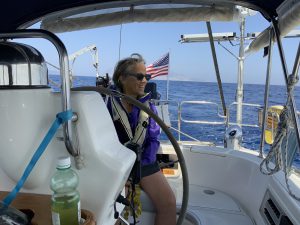
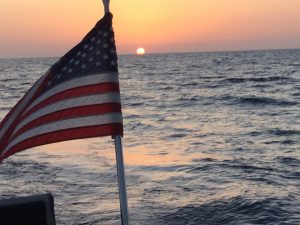
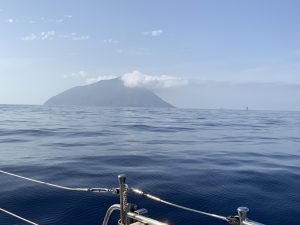
At least it enabled us to make water along the way, shower before arriving and arrive with full tanks. At around 8am on our third day, Howard woke me as the first two of seven volcanic islands that comprise the Aeolian Islands appeared out of the haze. Our course took us between Isola di Ficudi and Isola di Salina, past the largest island, Isola di Lipari then through the relatively narrow passage between Lipari and Vulcano.
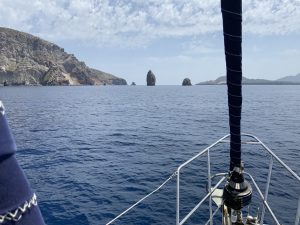
Although it was hazy, the volcanic islands were spectacular with their spiky rocky outcrops. We were greeted by a guy in a RIB as we entered Porto Levante on the NE end of the island who offered to guide us to one of his mooring balls. We happily accepted, knowing we were in need of a worry-free night to catch up on lost sleep.
Next morning, refreshed and revitalized, we took our friendly RIB guy up on his offer to ferry us to the port along with a lovely couple from Corsica (who were on an adjacent mooring) so we could hike up to the rim of the still active vulcano. We ended up hiking together, taking it relatively slowly with breaks along the way to enjoy the view. It was well worth the 300+ meter elevation climb, even if the sulphurous gases emanating from the ground made it somewhat smelly on occasions. We now knew where the yellow deposits that we saw on the surface of the water as we neared Vulcano had come from!
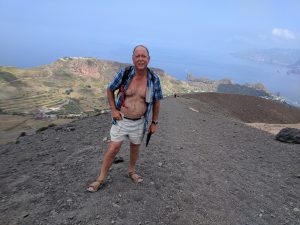

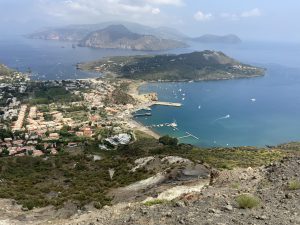
We had thought of trying a mud bath after the hike, which is claimed to be beneficial in the treatment of all sorts of dermatological ailments and arthritis, but we all instead opted for a lovely cool beer before calling our taxi man and returning to our boats. A swim a little later was most refreshing, even though the water temperature must be elevated by the hot springs near the beach.
Vulcano has a laid back feel to it, even though there are numerous ferries arriving and departing throughout the day. We were most impressed by the hydrofoil ferries that remained up on their foils until quite close to the harbour and created very little wake, though unfortunately we can’t say that about some of the others.
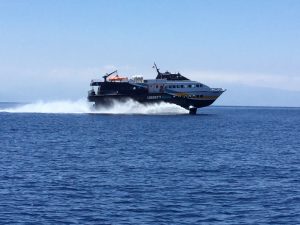
You can thank the Romans for the derivation of the noun ‘volcano’, as this was the name they gave to this island, after their god ‘Vulcan’, of fire. The Romans used the island to harvest timber, and mine alum and sulphur. In 1860 a Scottish industrialist and philanthropist, James Stevenson, bought the northern part of the island, built a villa, reopened the mine, and developed a vineyard to produce Malmsey wine.There was an interesting restaurant called Stevenson’s Cantina, which served some great cocktails, named after him. Bad timing on his part as the volcano erupted for about two years, 1868-70. He sold his land to the locals. The volcano hasn’t erupted since. Vulcano is one of four Italian active non-submarine volcanos; others being Stromboli (the northernmost Aeolian island), Etna, and Vesuvius. The Greeks also knew the island calling it Thermessa (source of heat). The island appeared in their myths as the private foundry of the Olympian god Hephaestus, the patron of blacksmiths. Did Shakespeare know about Vulcano? According to one interpretation ‘The Tempest’ is set in Vulcano, rather than on the more broadly accepted Bermuda.
Now we are anchored off the port of Milazzo, Sicily, having again had light winds on the way here, hopefully the forecast is correct and winds will continue to be light overnight as we are not very far away from a rocky shore!
Milazzo seems to be a place of contrasts, a busy, very industrial port on one side of us and beautiful buildings, including a fortified old town, on the other. Unfortunately we probably won’t go ashore to explore it but instead relax onboard in preparation for an early start in the morning to traverse the oft written about Straights of Messina. It could be a long day if, as we plan to, we make Taormina our next stop, an estimated passage time of 9-10 hours, though Messina (~5 hours) is another option. Hopefully, our passage south will be aided by a current up to 6 kts, assuming we have read our tide-tables correctly!
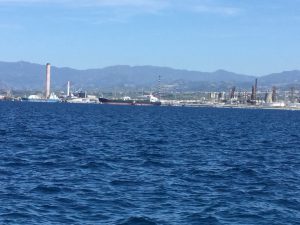
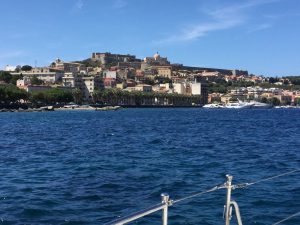
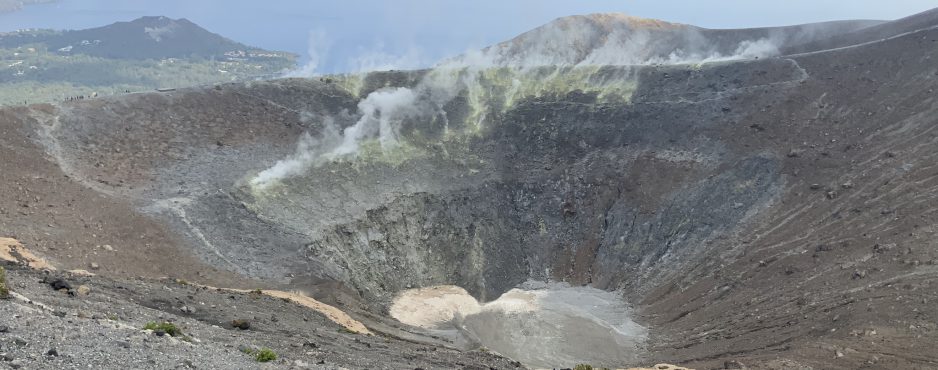
3 Comments
Jonathan
Fascinating stuff! Thanks for doing these in such detail inc pics etc. Very entertaining and educational. J
Cheryll
Wow great adventure! Fab pics. Enjoy the next leg.
Ruth and Nick Pearman
I knew nothing of these Aeolian Islands. Your pictures and narrative are really fantastic. Just glad there were no sudden eruptions after all these quiet years. And safe, happy sailing today through Straits of Messina. Rx